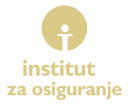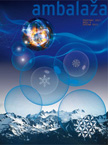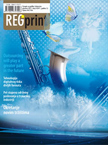«
Povratak na sadržaj
Broj 1 | Godina 2017

Save Food je velika priča koja će se zasigurno nastaviti
The first exhibition of the awarded packaging solutions that save food of the WPO member countries will be set up at this year’s Interpack. Around 18 countries will present their solutions and emphasize the importance and role of packaging.
Svjetska organizacija za ambalažu (WPO), zajedno sa svojim članicama, aktivno je uključena u Save Food Inicijativu koja globalno promiče i podržava napore vezane za sprječavanje gubitka hrane, s naglaskom na važnost i ulogu ambalaže u rješavanju ovog problema. Jedan od načina na koji se WPO uključio u promicanje ove Inicijative je i kroz kategoriju “Save Food – dodana vrijednost”, odnosno kroz nacionalne nagrade svojih članica za ambalažna rješenja koja dodaju vrijednost pakiranju kako bi se spriječili gubici hrane.
Ove godine, u sklopu sajma Interpack, održat će se prva izložba nagrađenih Save Food rješenja, što je bio i neposredan povod za razgovor s dr. Johannesom Bergmairom, potpredsjednikom WPO-a za održivost i sigurnost hrane, koji je i izravno uključen u organizaciju izložbe.
Na izložbi će biti pokazana na nacionalnoj razini nagrađena rješenja ukupno 18 članica WPO, uključujući i ona hrvatskog Instituta za ambalažu i tiskarstvo Tectus- IatT. Rješenja su to koja pokazuju da ambalaža nikako nije problem kada je u pitanju gubitak hrane, nego svakako dio rješenja i stoga će, kako ističe Bergmair, WPO i dalje nastaviti djelovati u pravcu promoviranja važnosti ove Inicijative te poziva sve uključene strane da se intenzivnije uključe jer samo zajedničkim djelovanjem moguće je doći do pravih rješenja na dobrobit svih uključenih u prehrambeni lanac.
World Packaging Organization (WPO), together with its members, has been actively involved in Save Food Initiative that globally promotes and supports efforts related to the prevention of food loss and waste by emphasizing the importance and role of packaging. One of the ways in which WPO is included in the Initiative is through the national awards of its members for packaging that saves food. The first exhibition of the awarded packaging solutions that save food of the WPO member countries will be set up at this year’s Interpack. We have talked with dr. Johannes Bergmair, WPO Vice President for Sustainability & Food Safety who is directly involved in the exhibition organization.
Q: Interpack is almost here. How will WPO be represented at this year’s fair?
A: As you already know, the focus will be on the exhibition of the packaging that saves food. WPO and its members will provide exhibition. It means that members of WPO will contribute by exhibiting awarded (over the last couple of years) solutions of the packaging that saves food.
Beside this exhibition, there will also be a WPO spring meeting and a WorldStar Award ceremony during Interpack.
WPO members will as usual have an executive meeting, a board member meeting and of course meetings in working groups – education, sustainability and marketing. Board members will elect a new president who will start his duty as of January 2018.
Focus of the education working group will be on educational programs for Africa and South Asia, while sustainability group will focus on Save Food, the exhibition and on ways to continue with this work after the Interpack.
Q: As you said, the emphasis will be on the exhibition of Save Food solutions. In what way will this pavilion be designed?
A: Exhibition of the packaging that saves food will be located in the so-called Innovationparc pavilion. In this area all the Save Food activities of Interpack and Messe Düsseldorf will be concentrated. The WPO will participate with the presentation of different countries – around 18 countries will present their solutions of the awarded packaging that saves food.
Beside the national winners and the Save Food WorldStar winners, WorldStar Student winners in the student category of the packaging solutions that save food will also be exhibited.
Q: As vice president of WPO, one of the parties included in the Save Food initiative, are you satisfied with the achievements accomplished so far?
A: You know I’m never satisfied, but I don’t mean that in a negative way. I think it’s absolute precious and it’s good that the initiative exists. A lot of work has already been done and we have collected many data. For example, WPO has done a lot through the national programs of the member countries, especially when it comes to public relations activities, emphasizing the topic and working on it. At the end, this will also be seen at the exhibition.
It is important that there are already many solutions on the market and that we have winners for packaging that saves food category in our national and international awards, but there is still a lot of work to do. If we would like to have better solutions, we have to go on with this topic.
As I have said, there are already many packaging solutions that save food on the market, but they are depending upon the country. Of course, the solutions are different in the developing and developed countries. Africa and Asia packaging that save food solutions are much different from the ones we have in Europe or USA, where the industry is familiar with high-sophisticated solutions, such as active and intelligent packaging, or portion size packaging, or packaging with high performance barrier. It is still a problem in the developing countries to use a proper packaging material.
Q: What would be your message to the companies on why to join the Save Food initiative? Are you satisfied with the extent to which WPO members are involved in the initiative?
A: Save Food and packaging that saves food make a very important topic for food and packaging industries. Especially for packaging industry, because for the first time in many, many years we have a topic where packaging can demonstrate in what way it can contribute to making a better environment and having good solutions for saving our environment by saving food. That’s why it is important that we work together on these solutions, so that every company and every country can implement the solutions. I’m very satisfied that all active members of WPO are involved in this initiative. This is a really good and big story and we should work on it.
Q: What are the next WPO steps towards Save Food initiative?
A: For sure, I can say that we will go on. We want to continue our cooperation with Save Food initiative and with Messe Düsseldorf and we expect some really important effect from this exhibition, from the weeklong Interpack and from being there, communicating with people and finding out the next steps we should focus on. It is an international work and we really have to be careful to focus on the right things, but make them right.
Q: Let’s go back to packaging. Packaging is a big part of the product’s success, but also a big part of the food waste problem. How to make peace between these two extremes?
A: What we can do is setting actions like what we do at Interpack. We have to identify the problem. For sure, there is a waste problem and the need of circular economy. We should also tell the consumers, the government structures and all other parties involved which solutions we already have, because there are already many solutions available. We have to stop looking at the packaging as a part of the problem, it is rather a part of the solutions.
Q: The numbers indicating the effect the thrown away food has on the environment are horrible. Nevertheless, the consumer habits are changing very slowly and hardly. How can we speed this process up?
A: We need to talk and to inform. For sure, this exhibition is also just one part, but it can show the consumers how important this initiative is. The communication about what packaging can do to reduce food waste shouldn’t be conducted by packaging companies separately, we should do it all together because then we are a big and loud voice. This shouldn’t be the story about glass, plastic and paper, it should be the story how important good packaging is in reducing food waste.
Q: Portion-sized packaging is a possible solution for reducing food waste. Why doesn’t the industry use it more?
A: Recognition of portion-sized packaging is very different from country to country. There are countries where these solutions are very common. For example, in countries like the Netherlands or the UK they are much more common than in some other. The question of portion-sized packaging is always a question of packaging waste. There is for sure more packaging waste because we need more packaging or packaging materials for portion-sized packaging and thus many companies are afraid that there would be a negative environmental impact. This is because they do not know the Save Food story. With little bit more of packaging material we maybe could reduce the impact of the whole product altogether. And this is the information we have to bring to the companies, to the consumers and to the public for discussion. Then such solutions like portion-sized packaging will have more response and will be more present on the market.
Q: We hear everybody talking about sustainability and circular economy. Where is packaging and packaging industry in that segment?
A: That’s really a big question and I think the emphasis is also on the Save Food discussion. The most important thing we should discuss and realize is that we should never discuss packaging alone when it comes to the circular economy and environmental issue. We always have to discuss packaging in combination with the packaged goods. For example, if you want to see whether the packaging is environmentally friendly or not we have to compare the system with packaged goods, because packaging has many functions, which are interacting with these goods, and if you do not include these functions in your environmental consideration, then you will get the misleading results.
Interview by: Željka Livaić
Ove godine, u sklopu sajma Interpack, održat će se prva izložba nagrađenih Save Food rješenja, što je bio i neposredan povod za razgovor s dr. Johannesom Bergmairom, potpredsjednikom WPO-a za održivost i sigurnost hrane, koji je i izravno uključen u organizaciju izložbe.
Na izložbi će biti pokazana na nacionalnoj razini nagrađena rješenja ukupno 18 članica WPO, uključujući i ona hrvatskog Instituta za ambalažu i tiskarstvo Tectus- IatT. Rješenja su to koja pokazuju da ambalaža nikako nije problem kada je u pitanju gubitak hrane, nego svakako dio rješenja i stoga će, kako ističe Bergmair, WPO i dalje nastaviti djelovati u pravcu promoviranja važnosti ove Inicijative te poziva sve uključene strane da se intenzivnije uključe jer samo zajedničkim djelovanjem moguće je doći do pravih rješenja na dobrobit svih uključenih u prehrambeni lanac.
World Packaging Organization (WPO), together with its members, has been actively involved in Save Food Initiative that globally promotes and supports efforts related to the prevention of food loss and waste by emphasizing the importance and role of packaging. One of the ways in which WPO is included in the Initiative is through the national awards of its members for packaging that saves food. The first exhibition of the awarded packaging solutions that save food of the WPO member countries will be set up at this year’s Interpack. We have talked with dr. Johannes Bergmair, WPO Vice President for Sustainability & Food Safety who is directly involved in the exhibition organization.
Q: Interpack is almost here. How will WPO be represented at this year’s fair?
A: As you already know, the focus will be on the exhibition of the packaging that saves food. WPO and its members will provide exhibition. It means that members of WPO will contribute by exhibiting awarded (over the last couple of years) solutions of the packaging that saves food.
Beside this exhibition, there will also be a WPO spring meeting and a WorldStar Award ceremony during Interpack.
WPO members will as usual have an executive meeting, a board member meeting and of course meetings in working groups – education, sustainability and marketing. Board members will elect a new president who will start his duty as of January 2018.
Focus of the education working group will be on educational programs for Africa and South Asia, while sustainability group will focus on Save Food, the exhibition and on ways to continue with this work after the Interpack.
Q: As you said, the emphasis will be on the exhibition of Save Food solutions. In what way will this pavilion be designed?
A: Exhibition of the packaging that saves food will be located in the so-called Innovationparc pavilion. In this area all the Save Food activities of Interpack and Messe Düsseldorf will be concentrated. The WPO will participate with the presentation of different countries – around 18 countries will present their solutions of the awarded packaging that saves food.
Beside the national winners and the Save Food WorldStar winners, WorldStar Student winners in the student category of the packaging solutions that save food will also be exhibited.
Q: As vice president of WPO, one of the parties included in the Save Food initiative, are you satisfied with the achievements accomplished so far?
A: You know I’m never satisfied, but I don’t mean that in a negative way. I think it’s absolute precious and it’s good that the initiative exists. A lot of work has already been done and we have collected many data. For example, WPO has done a lot through the national programs of the member countries, especially when it comes to public relations activities, emphasizing the topic and working on it. At the end, this will also be seen at the exhibition.
It is important that there are already many solutions on the market and that we have winners for packaging that saves food category in our national and international awards, but there is still a lot of work to do. If we would like to have better solutions, we have to go on with this topic.
As I have said, there are already many packaging solutions that save food on the market, but they are depending upon the country. Of course, the solutions are different in the developing and developed countries. Africa and Asia packaging that save food solutions are much different from the ones we have in Europe or USA, where the industry is familiar with high-sophisticated solutions, such as active and intelligent packaging, or portion size packaging, or packaging with high performance barrier. It is still a problem in the developing countries to use a proper packaging material.
Q: What would be your message to the companies on why to join the Save Food initiative? Are you satisfied with the extent to which WPO members are involved in the initiative?
A: Save Food and packaging that saves food make a very important topic for food and packaging industries. Especially for packaging industry, because for the first time in many, many years we have a topic where packaging can demonstrate in what way it can contribute to making a better environment and having good solutions for saving our environment by saving food. That’s why it is important that we work together on these solutions, so that every company and every country can implement the solutions. I’m very satisfied that all active members of WPO are involved in this initiative. This is a really good and big story and we should work on it.
Q: What are the next WPO steps towards Save Food initiative?
A: For sure, I can say that we will go on. We want to continue our cooperation with Save Food initiative and with Messe Düsseldorf and we expect some really important effect from this exhibition, from the weeklong Interpack and from being there, communicating with people and finding out the next steps we should focus on. It is an international work and we really have to be careful to focus on the right things, but make them right.
Q: Let’s go back to packaging. Packaging is a big part of the product’s success, but also a big part of the food waste problem. How to make peace between these two extremes?
A: What we can do is setting actions like what we do at Interpack. We have to identify the problem. For sure, there is a waste problem and the need of circular economy. We should also tell the consumers, the government structures and all other parties involved which solutions we already have, because there are already many solutions available. We have to stop looking at the packaging as a part of the problem, it is rather a part of the solutions.
Q: The numbers indicating the effect the thrown away food has on the environment are horrible. Nevertheless, the consumer habits are changing very slowly and hardly. How can we speed this process up?
A: We need to talk and to inform. For sure, this exhibition is also just one part, but it can show the consumers how important this initiative is. The communication about what packaging can do to reduce food waste shouldn’t be conducted by packaging companies separately, we should do it all together because then we are a big and loud voice. This shouldn’t be the story about glass, plastic and paper, it should be the story how important good packaging is in reducing food waste.
Q: Portion-sized packaging is a possible solution for reducing food waste. Why doesn’t the industry use it more?
A: Recognition of portion-sized packaging is very different from country to country. There are countries where these solutions are very common. For example, in countries like the Netherlands or the UK they are much more common than in some other. The question of portion-sized packaging is always a question of packaging waste. There is for sure more packaging waste because we need more packaging or packaging materials for portion-sized packaging and thus many companies are afraid that there would be a negative environmental impact. This is because they do not know the Save Food story. With little bit more of packaging material we maybe could reduce the impact of the whole product altogether. And this is the information we have to bring to the companies, to the consumers and to the public for discussion. Then such solutions like portion-sized packaging will have more response and will be more present on the market.
Q: We hear everybody talking about sustainability and circular economy. Where is packaging and packaging industry in that segment?
A: That’s really a big question and I think the emphasis is also on the Save Food discussion. The most important thing we should discuss and realize is that we should never discuss packaging alone when it comes to the circular economy and environmental issue. We always have to discuss packaging in combination with the packaged goods. For example, if you want to see whether the packaging is environmentally friendly or not we have to compare the system with packaged goods, because packaging has many functions, which are interacting with these goods, and if you do not include these functions in your environmental consideration, then you will get the misleading results.
Interview by: Željka Livaić














